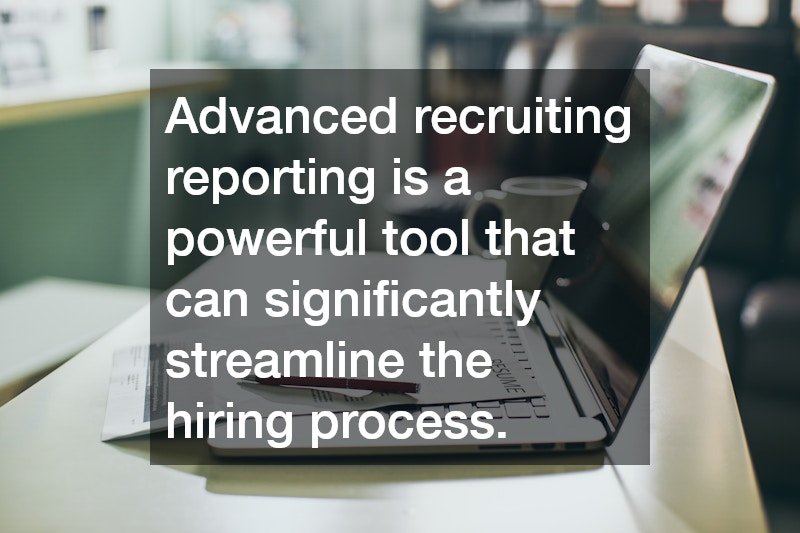

The hiring process is a critical component of any successful organization. Tracking and optimizing this process can determine the quality of talent that joins your company and, by extension, the success of your business. Here, we delve into the importance of streamlining the hiring process and introduce how advanced recruiting reporting can play a transformative role.
Advanced recruiting reporting is an essential part of modern human resources practices. It enables companies to analyze and refine their recruiting strategies, thus ensuring efficiency and effectiveness.
When organizations streamline their hiring processes using advanced data analytics, they can significantly reduce hiring time and improve the quality of their hires.
Moreover, advanced recruiting reporting offers a data-driven foundation for making informed decisions. By leveraging data, companies can adjust their recruitment strategies in real-time, leading to improved candidate experiences and more successful hires. This article will guide you through the benefits and implementation of advanced recruiting reporting in your hiring process.
What are the Benefits of Advanced Recruiting Reporting?
Implementing advanced recruiting reporting can provide numerous benefits to an organization. One of the most significant advantages is the increase in efficiency across the recruitment cycle. By automating repetitive tasks and leveraging data analysis, HR teams can focus on more strategic elements such as building relationships with potential hires and enhancing the candidate experience.
Advanced recruiting reporting also supports better data-driven decisions. With access to detailed analytics, recruitment teams can make predictive analyses to forecast hiring trends and tailor recruiting strategies accordingly. This ensures that recruitment efforts align with organizational goals and market demands, ultimately leading to more successful outcomes.
Furthermore, the candidate experience is greatly improved when recruiting processes are optimized. Candidates appreciate a quick and transparent hiring process, which can be achieved by leveraging advanced reporting tools. Smoother, faster procedures make candidates feel respected and valued, enhancing the company’s reputation and increasing the likelihood of securing top talent.
How Can You Get Started with Advanced Recruiting Reporting?
To begin using advanced recruiting reporting, the initial step is selecting the right software that aligns with your organizational goals. Research and compare different tools available in the market to determine which one best suits your needs. Consider factors such as ease of use, integrations with existing systems, and the ability to customize reports based on unique requirements.
Once the software is in place, it is crucial to set clear objectives and key performance indicators (KPIs) for the recruitment process. Establish goals related to hiring timelines, candidate quality, and retention rates. These objectives will serve as benchmarks to measure the success of your recruiting strategies and make adjustments as necessary.
The final step is consistent measurement and evaluation of your recruitment efforts. Regularly analyze the data gathered by your reporting tool to gain insights into the performance of different recruitment channels and strategies. Use this information to refine your approach, ensuring alignment with changing market conditions and organizational needs.
What are Common Challenges and How Can You Overcome Them?
Despite the benefits, many organizations face challenges when incorporating advanced recruiting reporting. A common hurdle is the resistance to change, particularly from traditional HR teams who may be unfamiliar with data-driven recruitment tools. To overcome this, it is essential to provide adequate training and highlight the advantages that such tools offer in enhancing efficiency and decision-making.
Data privacy concerns also pose a significant challenge. With advanced recruiting reporting, large amounts of candidate data are collected and analyzed, raising concerns about data security. Implementing strong data protection measures and ensuring compliance with relevant regulations is crucial to maintaining trust and safeguarding sensitive information.
Additionally, accurately interpreting data and deriving actionable insights can be daunting. Organizations must invest in educating their teams on data literacy and analytics. This equips HR professionals with the skills to transform raw data into meaningful information, enabling strategic decision-making that aligns with business objectives.
Conclusion
In conclusion, advanced recruiting reporting is a powerful tool that can significantly streamline the hiring process. By embracing data-driven strategies, organizations can achieve increased efficiency, make better-informed decisions, and enhance the candidate experience. In an era where talent is a key driver of business success, leveraging advanced recruiting reporting is not just beneficial, but essential.
The journey to implementing advanced recruiting reporting begins with selecting the right tools and setting clear objectives. By overcoming common challenges through education, training, and security measures, organizations can successfully integrate these tools into their recruitment processes.
By doing so, companies are well-equipped to hire top-quality candidates swiftly and effectively, ensuring they remain competitive and capable of responding to ever-evolving market demands. Advanced recruiting reporting thus stands as a cornerstone of modern recruitment strategies, driving business success through optimized hiring practices.



